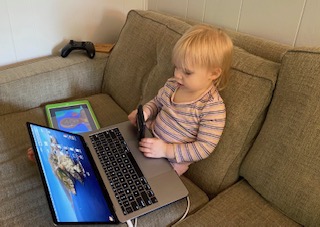Here at Bellwether, we consider our people a big asset (we even made a video about how much we like working together). We fancy ourselves as a fun, smart, and high-achieving group committed to facing the biggest challenges in education. Many of our team members were classroom teachers prior to entering administrative, policy, evaluation, and strategy roles at Bellwether, so overseeing the education of our own children should come naturally — right?

Photo courtesy the author
Not exactly. Even with the benefits of a work-from-home culture, a core value of flexibility, and myriad other forms of access and privilege, my teammates are struggling. Many of us are now juggling being both a parent and a professional within the same limited hours in a day.
When I asked the Bellwether parents of pre-Kindergarten through high-school-age students to share their experiences, I got a number of candid responses. Even these competent, tech-savvy, education professionals identified palpable struggles managing their time, knowing how to prioritize support of their home learners, and meeting the individual needs of each child.
The Bellwether parents who responded live in eight different states (Colorado, Illinois, Maryland, Massachusetts, North Carolina, Ohio, Texas, and Virginia), and collectively, they have 21 students. Most states were still in the early stages of closure when I conducted these polls, so the experiences below may not reflect improvements schools have made or will make.
What I heard around communications, materials, and processes is both scary and encouraging:
Communication from schools varied across states and even within single districts. Parents heard from administrators and teachers via email, text, and social media platforms created for this crisis. My colleagues reflected :
- “My 3rd grader was sent home with a packet of materials and other instructions; my 8th grader was sent home with a Chromebook only, no printed materials.”
- By day four of at-home school, one parent received daily teacher communications via email with instructions for specific work. “The volume has not been insignificant (and requires parental hand-holding).”
- “Oh, how I wish expectations were communicated to me.”
Technology was most effective where schools already had a platform in use before the crisis, such as Google Classroom. Zoom was adopted in some places and utilized for everything from one-on-one check-ins with teachers, morning “circle time,” to full-class participation with online instruction by the teacher. Many worried about the equity issues inherent with technology. Here is what my colleagues noted:
- “70% of our county doesn’t have broadband internet access…Zoom is not a reality we have access to here.”
- “Hand holding required from an adult [for an elementary-aged student] has been real…[I] appreciate the teacher even more.”
Scheduling and planning was a huge challenge for parents. They experienced everything from no suggested schedules from the school at all — to detailed ambitious daily schedules with regular mandatory check-ins. Depending on the school and grade, parents found the suggested plans took their students anywhere from 45 minutes to several hours to complete. And, of course, parents had to maintain their own work schedules as well. Here is what they shared about their typical day (with grade-level included):
- 1 hour per day, plus a chore, plus 30 minutes of reading (3rd and 8th)
- Three 90-minute blocks (9th)
- “4-ish hours per day of ‘instruction'” (3rd)
- The school’s goal of 3 hours/student is “impossible with two full-time working parents” (K and 4th)
- 2.5 hours per day (3rd)
- Approximately 45 minutes per day plus parental “supplements” (6th)
- “One hour of math worksheets; one hour of free reading; supplemental Bill Nye science videos” (K and 2nd)
Despite the challenges, my colleagues universally acknowledged the advantage of being able to work from home, helping them to keep their kids safe and healthy during this time. They also noted several bright spots such as family exercise time; more sleep for their kids; and a renewed appreciation for the creativity, adaptability, and general good humor of their children.
If you are feeling challenged during this unprecedented school closure experience, please know that you are not alone. One colleague reflected that this is a time to worry less about academics and more about the social and emotional learning aspects of our kids’ lives. These are trying circumstances, so do what you can. We stand with you as you face the challenges ahead — and Bellwether will continue to support parents, teachers, and the education sector with ideas, external resources, and encouragement.
